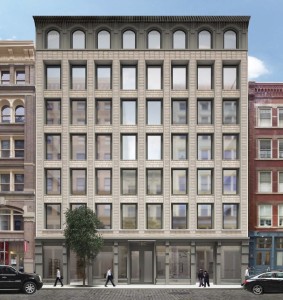
Rendering of 146-150 Wooster Street in Manhattan. Image Credit: KUB Capital.
Developers spent months engaging local representatives and neighborhood residents to garner their approval before formally initiating ULURP process. On January 28, 2016, the City Council Land Use Committee unanimously approved an application to construct a mixed-use building at 146–150 Wooster Street, located in Manhattan’s landmarked SoHo Cast-Iron Historic District. 150 Wooster LLC, the project developer and subsidiary of KUB real estate investment and design firm, is the second owner to attempt to build a new development in place of the existing and unused one-story garage. In the face of substantial community opposition, the previous site owner’s ULURP application was withdrawn before reaching the City Council.
KUB Co-founders Shawn Katz and Roger Bittenbender purchased the controversial site in the summer of 2014 from MTM Associates, LLC. MTM withdrew its 2012 ULURP application for the site due to significant community opposition despite City Planning approval. Katz and Bittenbender spent ten months reaching out to the community and tailoring a development proposal suitable to their needs and desires before initiating the ULURP process.
The eight-story building proposed by 150 Wooster LLC would reach slightly less than 100 feet in height and would occupy slightly more than 35,000 square feet. The ground floor would provide 6,000 square feet of retail space divided in half for use by two separate retailers. Six residential units and a penthouse would lie atop the retail space. The proposed building is contextually appropriate in the SoHo neighborhood, since most of the buildings in the surrounding area are five- to twelve-story industrial manufacturing plants converted into mixed-use buildings, which include ground floor retail space with Joint Live-Work Quarters for Artists, other types of residential units, or office spaces above the ground floor.
Since the site is located within the SoHo-Cast Iron Historic District, modifying any aspect of the site requires approval from the Landmarks Preservation Commission. Landmarks voted to approve the proposal on April 14, 2015 and issued a Certificate of Appropriateness on April 18th.
Manhattan Community Board 2 recommended approval of the proposal at its public hearing on October 22, 2015. On November 24, 2015, Manhattan Borough President Gale Brewer issued a recommendation for approval of the proposal, but expressed concerns about granting special permits to applicants seeking to rezone in furtherance of developments constructed in the SoHo and NoHo neighborhoods of Manhattan, especially when the project lacks an affordable housing component—as is the case in this development.
On December 2, 2015, the City Planning Commission held a public hearing on the proposed development. At the hearing, seven speakers testified in favor of the application and no speaker testified in opposition. A representative for Katz and Bittenbender testified to the project specifications, and he noted that concessions had been made along the way while undergoing community engagement. Five residents of neighboring buildings testified that the proposed building would not interfere with their ability to use and enjoy their homes, and they applauded the developer for the notable and extensive community outreach and engagement that preceded the initiation of the formal ULURP process. The City Planning Commission unanimously approved the application on January 6, 2016.
On January 26, 2016, the Subcommittee on Zoning and Franchises unanimously approved the application. At the January 26th hearing, Sean Katz testified that upon acquiring the property in the summer of 2014, he and Roger Bittenbender scrapped MTM’s building plans entirely and underwent extensive community engagement before formally initiating the ULURP process. Throughout this process, Katz and Bittenbender made several changes and concessions to meet the communities’ needs and desires. For example, the developers had originally planned to have one large retail space on the ground floor, but in response to community input, the proposed development provides two retail spaces—one on each side of the ground floor. Also, Katz and Bittenbender’s proposed development is four feet lower than the building proposed by MTM.
Council member Margaret Chin, who represents Lower Manhattan, testified that the proposed project is the result of over a year of the developer’s efforts in working with the community and “paying careful attention to the needs of these residents, many of whom have been in the community for decades.” The proposed building would provide “greatly improved living conditions” for the JLWQA tenants than MTM’s proposed project, as it would include the addition of new, energy-efficient windows and an easement that would preserve the open flow of air and light.
Zoning and Franchises Subcommittee Chair Donovan Richards, Jr. thanked and applauded Katz and Bittenbender for working with Council member Chin and the community before filing their application with the City, which is something that “most developers don’t do.”
Council member Antonio Reynoso noted that the proposal lacked affordable housing provisions. “This is all market-rate. We’re continuing to build for the people that don’t necessarily need it,” said Council member Reynoso. He expressed his view that the City should be asking for more in exchange for granting special permits for residential use, and he stressed the need to find a balance between “the preservation of a building’s character versus the preservation of the people of this City.”
Richard Godosky, a resident of 152 Wooster Street adjoining the proposed building’s site, testified in support of the proposal. Godosky testified to MTM’s unaccommodating nature in the face of substantial community opposition and, in contrast, noted that 150 Wooster LLC has been very willing to make changes, in response to community input, to both the outside and inside of the proposed building.
The full City Council is expected to vote on the proposal at its stated meeting on February 5, 2016.
City Council: LU 0329-2016; 0330-2016; 0331-2016 (Jan. 28, 2016).
By: Jessica Soultanian-Braunstein (Jessica is the CityLaw Fellow and a New York Law School Graduate, Class of 2015)

